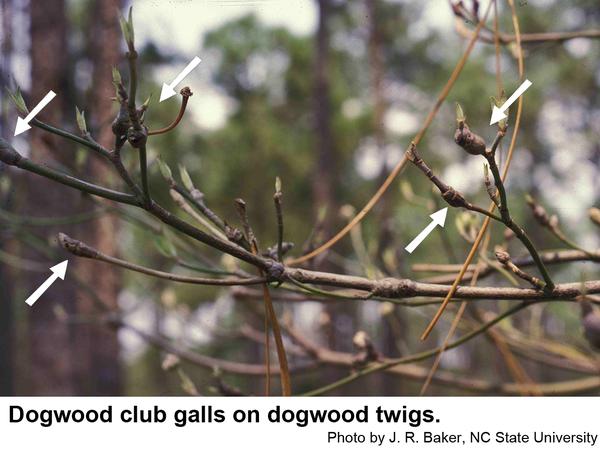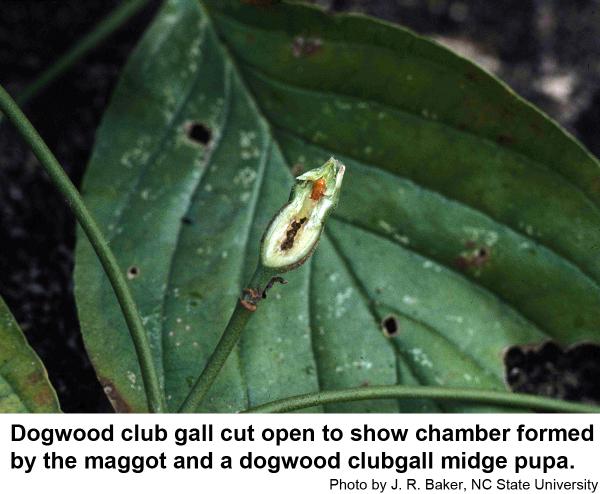Description and Biology
Dogwood clubgall midges, Resseliella clavula, are tiny flies that emerge in spring as the new leaf growth resumes on dogwoods. The delicate adult is about 1/16 inch long. The abdomen is bright orange; the thorax is yellow orange or duller. The wings are mottled with varying patches of black and yellow hairs, which resemble irregular, black and yellow bands on some specimens. The male's antennae are about the same length as the body; the joints are beadlike. Females' antennae are shorter and less conspicuous. Larva are tiny orange maggots. Females lay eggs in newly developing buds, and as the maggots hatch and feed, their saliva causes a swollen, tough gall to form around them. The maggots develop inside the gall until late summer. In autum, maggots emerge from the galls by chewing small, round holes through the sides. They drop to the soil under the dogwood trees, where they overwinter probably in a tiny silk cocoon. Pupation occurs the following spring. In late spring, adults emerge and lay their eggs among the minute terminal leaves. Usually the eggs are laid on the most vigorous twigs where the nodes are close together in the developing bud. Upon hatching, the maggots work their way into the interior of the leaf base or into petioles at the junction of the apical pair or two pairs of minute terminal leaves. Occasionally, entrance to the midrib may be through adjacent leaf tissue. This feeding causes the formation of an elongate gall, where the maggots live in a central cavity. From 1 to 39 maggots may be found per gall.
Host Plant
Dogwood seems to be the only host for the dogwood clubgall midge. The dogwood clubgall midge causes club- or spindle-shaped tubular swellings (galls) from half to 1 inch long at the tips or along the stems of dogwood twigs. The twig beyond a gall may die. From 30 to 120 galls per tree have been reported. Some of the twigs may die above the swollen part, and trees are deformed when infestations are heavy.
Residential Recommendations
Once the gall has formed, it is impossible to control the midge maggots inside with pesticides. Some sort of contact pesticide could be applied just as the leaf buds are breaking to give adequate control of dogwood clubgall midges. Once the galls have formed, pruning is probably the only management option.
Other Resources
- Dogwood Clubgall. Felt, E. P. and S. W. Bromley. 1939. Bartlett Tree Research Lab. Bull. 3: 30 - 33.
- Dogwood Club Gall. Schread, J. C. 1964. Connecticut Agr. Exp. Sta. (New Haven) Circ. 225. 6 pp.
- Dogwood Clubgall Midge in Insect and Related Pests of Shrubs. Baker, J. R. ed. 1980. NC Agr. Ext. Service pub. AG-189. 199 pp.
- Dogwood Diseases & Insect Pests. Doubrava, N. et al. 2021 (update). Clemson Cooperative Extension Factsheet HGIC 2003.
- Extension Plant Pathology Publications and Factsheets
- Horticultural Science Publications
- North Carolina Agricultural Chemicals Manual
For assistance with a specific problem, contact your local N.C. Cooperative Extension center.
This Factsheet has not been peer reviewed.
Publication date: Feb. 14, 2019
Reviewed/Revised: Nov. 30, 2023
Recommendations for the use of agricultural chemicals are included in this publication as a convenience to the reader. The use of brand names and any mention or listing of commercial products or services in this publication does not imply endorsement by NC State University or N.C. A&T State University nor discrimination against similar products or services not mentioned. Individuals who use agricultural chemicals are responsible for ensuring that the intended use complies with current regulations and conforms to the product label. Be sure to obtain current information about usage regulations and examine a current product label before applying any chemical. For assistance, contact your local N.C. Cooperative Extension county center.
N.C. Cooperative Extension prohibits discrimination and harassment regardless of age, color, disability, family and marital status, gender identity, national origin, political beliefs, race, religion, sex (including pregnancy), sexual orientation and veteran status.


